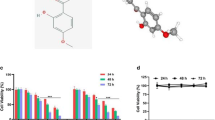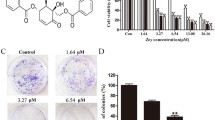Abstract
Fisetin is a naturally occurring flavonoid that has been reported to inhibit the proliferation and to induce apoptotic cell death in several tumor cells. However, the apoptosis-inducing effect of fisetin on tumor cell lines was investigated besides HeLa cells. In this study, we found that fisetin induced apoptosis of HeLa cells in a dose- and time-dependent manner, as evidenced by nuclear staining of 4′-6-Diamidino-2-phenylindole (DAPI), flow cytometry assay, and Annexin-V/PI double-labeling. In addition, fisetin triggered the activations of caspases-3 and -8 and the cleavages of poly (ADP-ribose) polymerase, resulting in apoptosis induction. Moreover, treatment of HeLa cells with fisetin induced a sustained activation of the phosphorylation of ERK1/2, and inhibition of ERK1/2 by PD98059 (MEK1/2 inhibitor) or transfection with the mutant ERK1/2 expression vector significantly abolished the fisetin-induced apoptosis through the activation of caspase-8/-3 pathway. The in vivo xenograft mice experiments revealed that fisetin significantly reduced tumor growth in mice with HeLa tumor xenografts. In conclusion, our results indicated that fisetin exhibited anti-cancer effect and induced apoptosis in HeLa cell lines both in vitro and in vivo.






Similar content being viewed by others
References
Birt DF, Hendrich S, Wang W (2001) Dietary agents in cancer prevention: flavonoids and isoflavonoids. Pharmacol Ther 90:157–177
Cagnol S, Van Obberghen-Schilling E, Chambard JC (2006) Prolonged activation of ERK1, 2 induces FADD-independent caspase 8 activation and cell death. Apoptosis 11:337–346
Chen YR, Wang X, Templeton D, Davis RJ, Tan TH (1996) The role of c-Jun N-terminal kinase (JNK) in apoptosis induced by ultraviolet C and gamma radiation. Duration of JNK activation may determine cell death and proliferation. J Biol Chem 271:31929–31936
Chen YC, Shen SC, Lee WR, Lin HY, Ko CH, Shih CM, Yang LL (2002) Wogonin and fisetin induction of apoptosis through activation of caspase 3 cascade and alternative expression of p21 protein in hepatocellular carcinoma cells SK-HEP-1. Arch Toxicol 76:351–359
Cobb MH (1999) MAP kinase pathways. Prog Biophys Mol Biol 71(3–4):479–500
da Rocha AB, Lopes RM, Schwartsmann G (2001) Natural products in anticancer therapy. Curr Opin Pharmacol 1:364–369
de Sousa RR, Queiroz KC, Souza AC, Gurgueira SA, Augusto AC, Miranda MA, Peppelenbosch MP, Ferreira CV, Aoyama H (2007) Phosphoprotein levels, MAPK activities and NFkappaB expression are affected by fisetin. J Enzym Inhib Med Chem 22:439–444
Deep G, Gangar SC, Oberlies NH, Kroll DJ, Agarwal R (2010) Isosilybin A induces apoptosis in human prostate cancer cells via targeting Akt, NF-kappaB, and androgen receptor signaling. Mol Carcinog 49:902–912
Dong C, Davis RJ, Flavell RA (2002) MAP kinases in the immune response. Annu Rev Immunol 20:55–72
Dubin RL, Hall CM, Pileri CL, Kudlacek PE, Li XY, Yee JA, Johnson ML, Anderson RJ (2001) Thermostable (SULT1A1) and thermolabile (SULT1A3) phenol sulfotransferases in human osteosarcoma and osteoblast cells. Bone 28:617–624
Eaton EA, Walle UK, Lewis AJ, Hudson T, Wilson AA, Walle T (1996) Flavonoids, potent inhibitors of the human P-form phenolsulfotransferase. Potential role in drug metabolism and chemoprevention. Drug Metab Dispos 24:232–237
Haddad AQ, Venkateswaran V, Viswanathan L, Teahan SJ, Fleshner NE, Klotz LH (2006) Novel antiproliferative flavonoids induce cell cycle arrest in human prostate cancer cell lines. Prostate Cancer Prostatic Dis 9:68–76
Haddad AQ, Fleshner N, Nelson C, Saour B, Musquera M, Venkateswaran V, Klotz L (2010) Antiproliferative mechanisms of the flavonoids 2, 2′-dihydroxychalcone and fisetin in human prostate cancer cells. Nutr Cancer 62:668–681
Hanneken A, Lin FF, Johnson J, Maher P (2006) Flavonoids protect human retinal pigment epithelial cells from oxidative-stress-induced death. Invest Ophthalmol Vis Sci 47:3164–3177
Hassan SW, Ladan MJ, Dogondaji RA, Umar RA, Bilbis LS, Hassan LG, Ebbo AA, Matazu IK (2007) Phytochemical and toxicological studies of aqueous leaves extracts of Erythrophleum africanum. Pak J Biol Sci 10:3815–3821
He J, Lin J, Li J, Zhang JH, Sun XM, Zeng CM (2009) Dual effects of Ginkgo biloba leaf extract on human red blood cells. Basic Clin Pharmacol Toxicol 104:138–144
Hsieh YH, Wu TT, Huang CY, Hsieh YS, Hwang JM, Liu JY (2007) p38 mitogen-activated protein kinase pathway is involved in protein kinase Calpha-regulated invasion in human hepatocellular carcinoma cells. Cancer Res 67:4320–4327
Hwang JM, Kao SH, Hsieh YH, Li KL, Wang PH, Hsu LS, Liu JY (2009) Reduction of anion exchanger 2 expression induces apoptosis of human hepatocellular carcinoma cells. Mol Cell Biochem 327:135–144
Jiang B, Liu JH, Bao YM, An LJ (2004) Catalpol inhibits apoptosis in hydrogen peroxide-induced PC12 cells by preventing cytochrome c release and inactivating of caspase cascade. Toxicon 43:53–59
Johnson GL, Lapadat R (2002) Mitogen-activated protein kinase pathways mediated by ERK, JNK, and p38 protein kinases. Science 298:1911–1912
Khan N, Afaq F, Mukhtar H (2007) Apoptosis by dietary factors: the suicide solution for delaying cancer growth. Carcinogenesis 28:233–239
Khan N, Afaq F, Syed DN, Mukhtar H (2008a) Fisetin, a novel dietary flavonoid, causes apoptosis and cell cycle arrest in human prostate cancer LNCaP cells. Carcinogenesis 29:1049–1056
Khan N, Asim M, Afaq F, Abu Zaid M, Mukhtar H (2008b) A novel dietary flavonoid fisetin inhibits androgen receptor signaling and tumor growth in athymic nude mice. Cancer Res 68:8555–8563
Kim JY, Jeon YK, Jeon W, Nam MJ (2010) Fisetin induces apoptosis in Huh-7 cells via downregulation of BIRC8 and Bcl2L2. Food Chem Toxicol 48:2259–2264
Kuwana T, Newmeyer DD (2003) Bcl-2-family proteins and the role of mitochondria in apoptosis. Curr Opin Cell Biol 15:691–699
Le Marchand L (2002) Cancer preventive effects of flavonoids-a review. Biomed Pharmacother 56:296–301
Lee SW, Lee JT, Lee MG, Lee HW, Ahn SJ, Lee YJ, Lee YL, Yoo J, Ahn BC, Ha JH (2009) In vitro antiproliferative characteristics of flavonoids and diazepam on SNU-C4 colorectal adenocarcinoma cells. J Nat Med 63:124–129
Li J, Cheng Y, Qu W, Sun Y, Wang Z, Wang H, Tian B (2011) Fisetin, a dietary flavonoid, induces cell cycle arrest and apoptosis through activation of p53 and inhibition of NF-kappa B pathways in bladder cancer cells. Basic Clin Pharmacol Toxicol 108:84–93
Matsukawa J, Matsuzawa A, Takeda K, Ichijo H (2004) The ASK1-MAP kinase cascades in mammalian stress response. J Biochem 136:261–265
Mohammad RM, Banerjee S, Li Y, Aboukameel A, Kucuk O, Sarkar FH (2006) Cisplatin-induced antitumor activity is potentiated by the soy isoflavone genistein in BxPC-3 pancreatic tumor xenografts. Cancer 106:1260–1268
Moon YJ, Wang X, Morris ME (2006) Dietary flavonoids: effects on xenobiotic and carcinogen metabolism. Toxicol In Vitro 20:187–210
Murtaza I, Adhami VM, Hafeez BB, Saleem M, Mukhtar H (2009) Fisetin, a natural flavonoid, targets chemoresistant human pancreatic cancer AsPC-1 cells through DR3-mediated inhibition of NF-kappaB. Int J Cancer 125:2465–2473
Pasqualini JR (2009) Estrogen sulfotransferases in breast and endometrial cancers. Ann N Y Acad Sci 1155:88–98
Ren W, Qiao Z, Wang H, Zhu L, Zhang L (2003) Flavonoids: promising anticancer agents. Med Res Rev 23:519–534
Shin GC, Kim C, Lee JM, Cho WS, Lee SG, Jeong M, Cho J, Lee K (2009) Apigenin- induced apoptosis is mediated by reactive oxygen species and activation of ERK1/2 in rheumatoid fibroblast-like synoviocytes. Chem Biol Interact 182:29–36
Shwed JA, Walle UK, Walle T (1992) Hep G2 cell line as a human model for sulphate conjugation of drugs. Xenobiotica 22:973–982
Smith HO, Tiffany MF, Qualls CR, Key CR (2000) The rising incidence of adenocarcinoma relative to squamous cell carcinoma of the uterine cervix in the United States-a 24-year population-based study. Gynecol Oncol 78:97–105
Snyder A, Alsauskas ZC, Leventhal JS, Rosenstiel PE, Gong P, Chan JJ, Barley K, He JC, Klotman ME, Ross MJ, Klotman PE (2010) HIV-1 viral protein r induces ERK and caspase-8-dependent apoptosis in renal tubular epithelial cells. AIDS 24:1107–1119
Suh Y, Afaq F, Johnson JJ, Mukhtar H (2009) A plant flavonoid fisetin induces apoptosis in colon cancer cells by inhibition of COX2 and Wnt/EGFR/NF-kappaB-signaling pathways. Carcinogenesis 30:300–307
Suh Y, Afaq F, Khan N, Johnson JJ, Khusro FH, Mukhtar H (2010) Fisetin induces autophagic cell death through suppression of mTOR signaling pathway in prostate cancer cells. Carcinogenesis 31:1424–1433
Sung B, Pandey MK, Aggarwal BB (2007) Fisetin, an inhibitor of cyclin-dependent kinase 6, down-regulates nuclear factor-kappaB-regulated cell proliferation, antiapoptotic and metastatic gene products through the suppression of TAK-1 and receptor-interacting protein-regulated IkappaBalpha kinase activation. Mol Pharmacol 71:1703–1714
Thorburn A (2004) Death receptor-induced cell killing. Cell Signal 16:139–144
Torres F, Quintana J, Diaz JG, Carmona AJ, Estevez F (2008) Trifolin acetate-induced cell death in human leukemia cells is dependent on caspase-6 and activates the MAPK pathway. Apoptosis 13:716–728
Wang X, Martindale JL, Holbrook NJ (2000) Requirement for ERK activation in cisplatin-induced apoptosis. J Biol Chem 275:39435–39443
Wilson DJ, Alessandrini A, Budd RC (1999) MEK1 activation rescues Jurkat T cells from Fas-induced apoptosis. Cell Immunol 194:67–77
Xia Z, Dickens M, Raingeaud J, Davis RJ, Greenberg ME (1995) Opposing effects of ERK and JNK-p38 MAP kinases on apoptosis. Science 270:1326–1331
Yin XM (2000) Bid, a critical mediator for apoptosis induced by the activation of Fas/TNF-R1 death receptors in hepatocytes. J Mol Med 78:203–211
Acknowledgments
This work was supported by grants from National Science Council, Taiwan (NSC 98-2314-B-040-024) and Chung Shan Medical Hospital, Taichung, Taiwan (CSH-2011-C-026). Freeze centrifuge was performed in the Instrument Center of Chung Shan Medical University, which is supported by National Science Council, Ministry of Education and Chung Shan Medical University.
Conflict of interest
The authors declare that there is no conflict of interest.
Author information
Authors and Affiliations
Corresponding authors
Additional information
An erratum to this article can be found at http://dx.doi.org/10.1007/s00204-011-0796-9
Rights and permissions
About this article
Cite this article
Ying, TH., Yang, SF., Tsai, SJ. et al. Fisetin induces apoptosis in human cervical cancer HeLa cells through ERK1/2-mediated activation of caspase-8-/caspase-3-dependent pathway. Arch Toxicol 86, 263–273 (2012). https://doi.org/10.1007/s00204-011-0754-6
Received:
Accepted:
Published:
Issue Date:
DOI: https://doi.org/10.1007/s00204-011-0754-6




